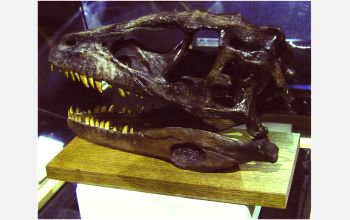Multimedia Gallery
Augmented Reality (Step 1)
Using augmented reality (AR) to recreate the physical skull of the predatory dinosaur Deinonychus--Step 1: The physical skull of the predatory dinosaur Deinonychus is placed inside the 3-D display of the computer-driven Virtual Showcase, a half-mirrored, conical chamber fitted with numerous projectors and lighting controls into which fossils are placed.
In the process, researchers will use stereoscopic 3-D overlays in combination with synchronized audio and light effects to "paint" the fossil with digital soft tissue and muscle, creating a dynamic model to reveal how the dinosaur may have looked, and how it may have attacked its prey. Up to two users stand outside the showcase and wear special glasses while the researchers control the lighting and projected graphics, creating a 3-D illusion of flesh and muscle enveloping original bone. The showcase will enable paleontologists to communicate their research results to a novice audience in an exciting and effective manner. [Image 1 in a series of 6. See Image 2.]
More about this Image
The paleontology applications of AR were developed by National Science Foundation (NSF)-supported researchers Stephen Gatesy of Brown University and Lawrence Witmer of Ohio University, in collaboration with Oliver Bimber of Bauhaus University in Germany and colleagues at the Mitsubishi Electronic Research Laboratory in Cambridge, Mass., and the Fraunhofer Center for Research in Computer Graphics in Providence, R.I.
Using Deinonychus as a test subject, the researchers used AR to determine where powerful jaw muscles may have attached to the animal's skull and hypothesized where muscle, skin and other parts would fit, based on observations of closely related modern animals. This information, along with a 3-D scan of the fossil, is stored in a standard desktop computer.
In addition to research, AR technology may also have future applications in museum exhibits, augmenting fossils for a variety of educational purposes and enhancing details on display specimens.
The research was funded by NSF grants DBI 99-74424, awarded to Stephen M. Gatesy, and IBN 96-01174, awarded to Lawrence M. Witmer. For further information, including a short film about the AR process used with the Deinonychus skull in this series of images, see the NSF News Tip story Augmented Reality Brings Dinosaurs into the 21st Century, dated Oct. 22, 2002. (Date of image: 2002)
SORRY: THIS IMAGE IS NOT AVAILABLE IN HIGH-RESOLUTION FORMAT
Credit: Images courtesy of Oliver Bimber, Bauhaus University, Germany; Stephen M. Gatesy, Brown University; Lawrence M. Witmer, Ohio University; Ramesh Raskar, Mitsubishi Electric Research Laboratories, MA; and Miguel Encarnacao, Fraunhofer CRCG.
Images and other media in the National Science Foundation Multimedia Gallery are available for use in print and electronic material by NSF employees, members of the media, university staff, teachers and the general public. All media in the gallery are intended for personal, educational and nonprofit/non-commercial use only.
Images credited to the National Science Foundation, a federal agency, are in the public domain. The images were created by employees of the United States Government as part of their official duties or prepared by contractors as "works for hire" for NSF. You may freely use NSF-credited images and, at your discretion, credit NSF with a "Courtesy: National Science Foundation" notation.
Additional information about general usage can be found in Conditions.
Also Available:
Download the high-resolution TIFF version of the image. (1.8 MB)
Use your mouse to right-click (Mac users may need to Ctrl-click) the link above and choose the option that will save the file or target to your computer.



